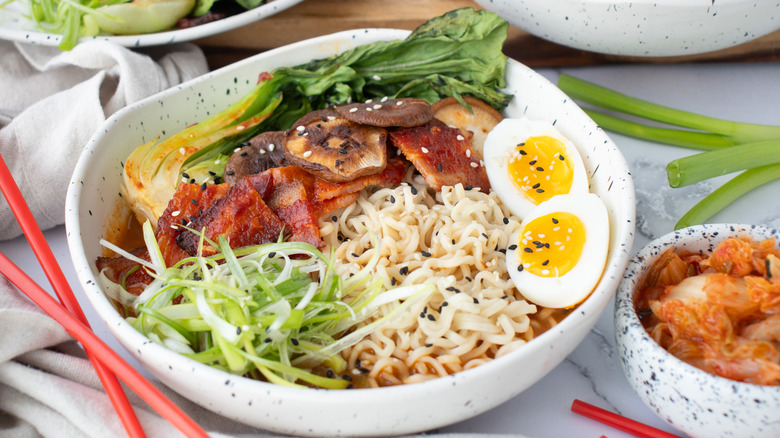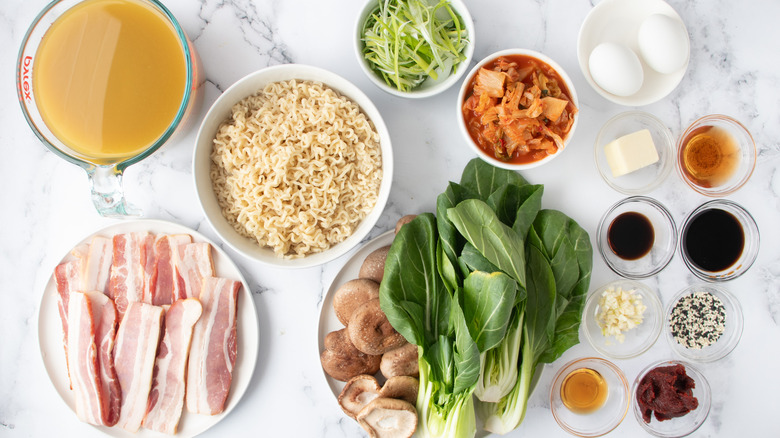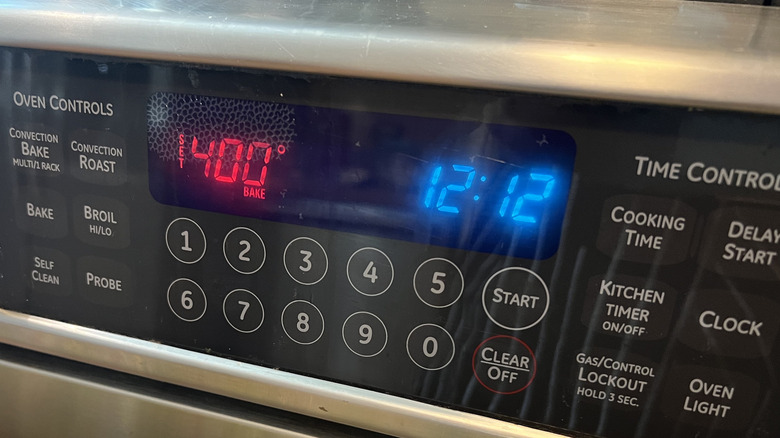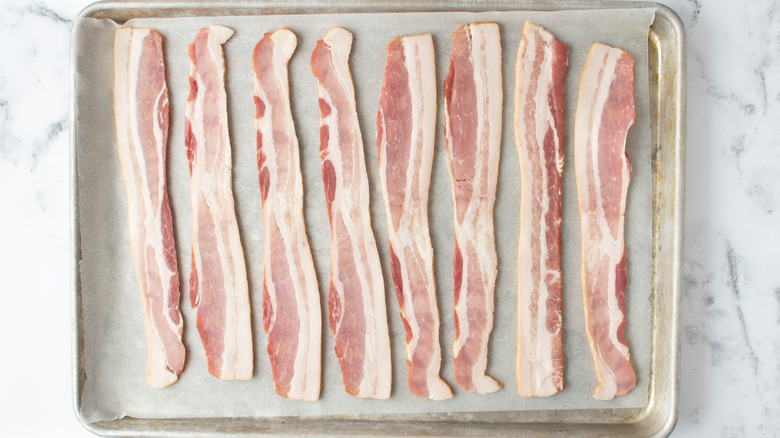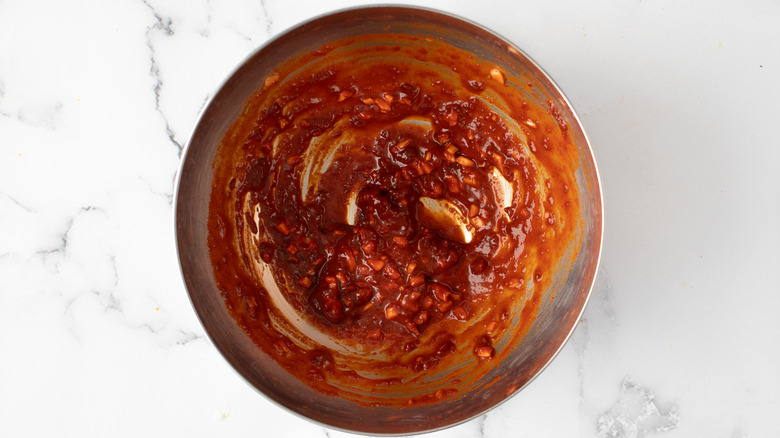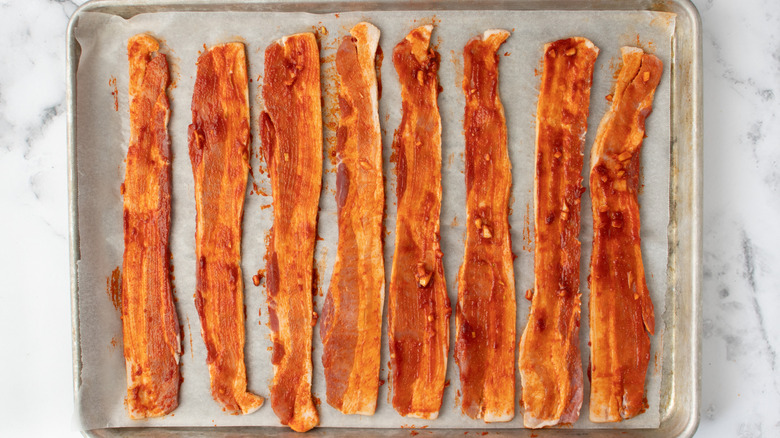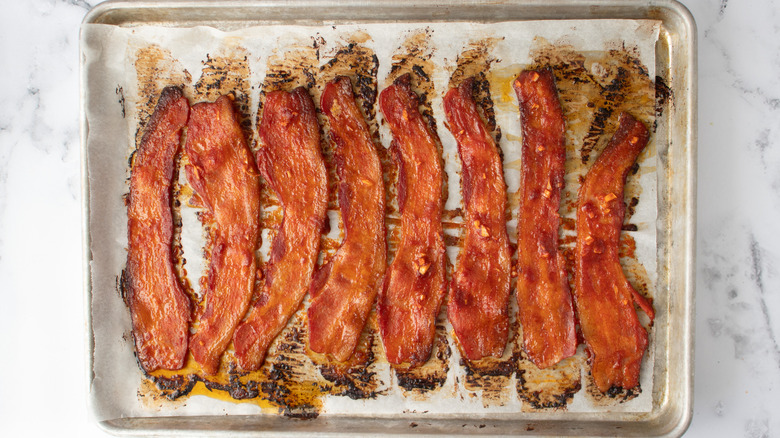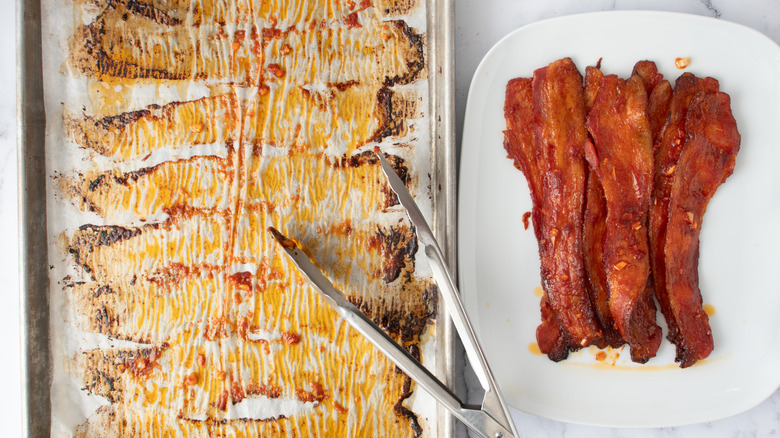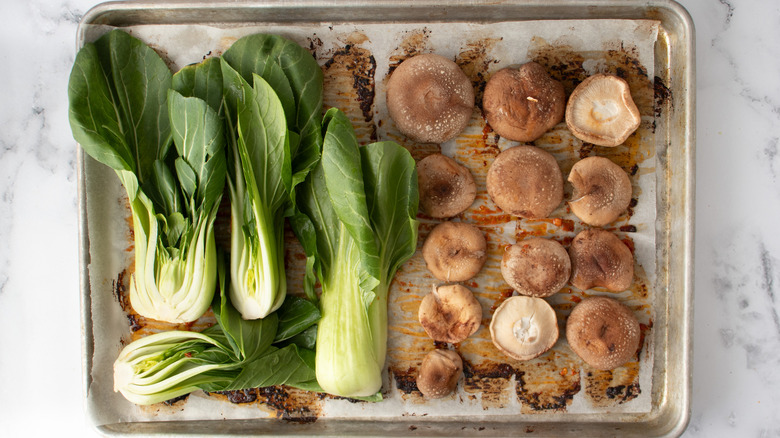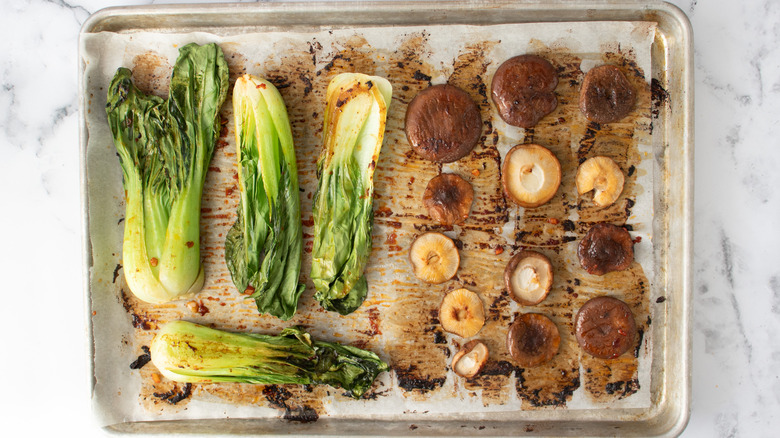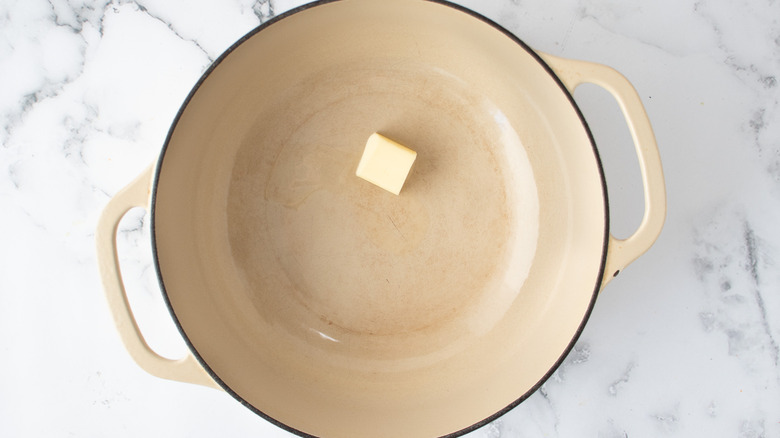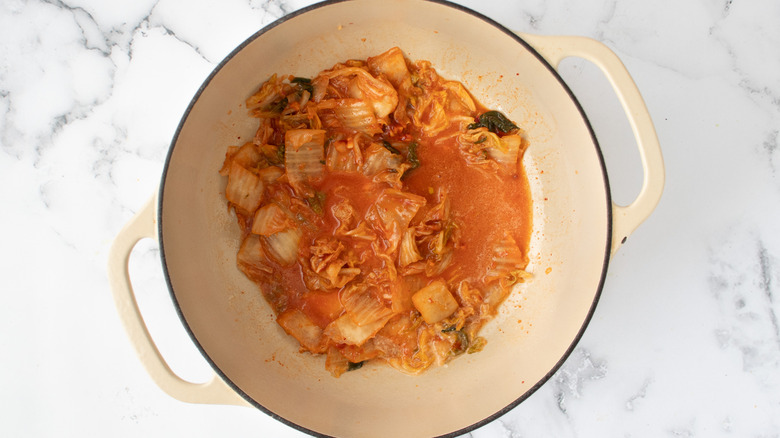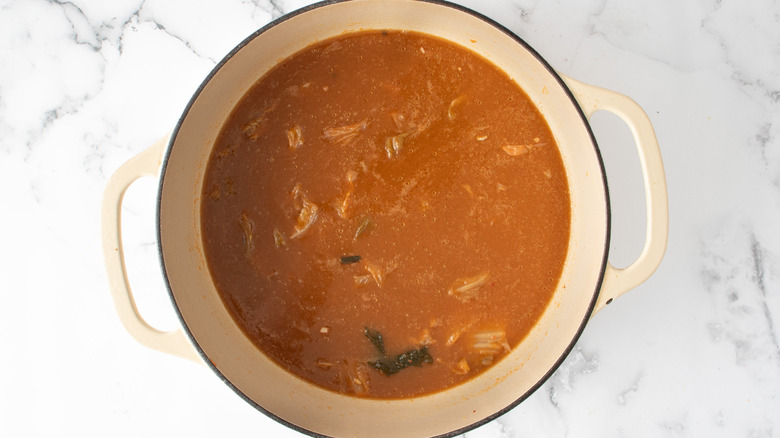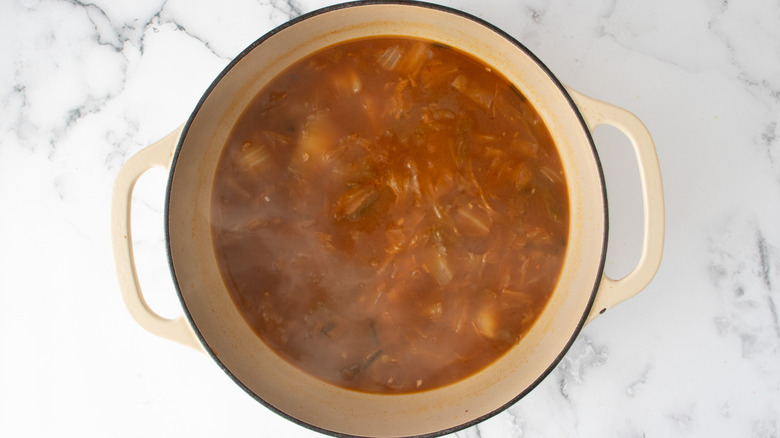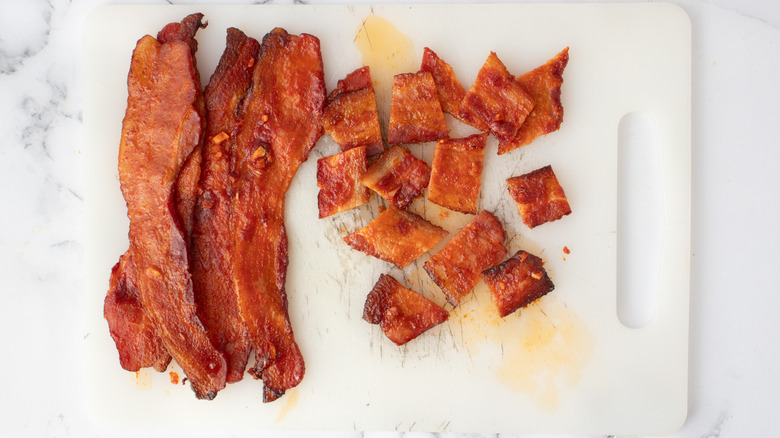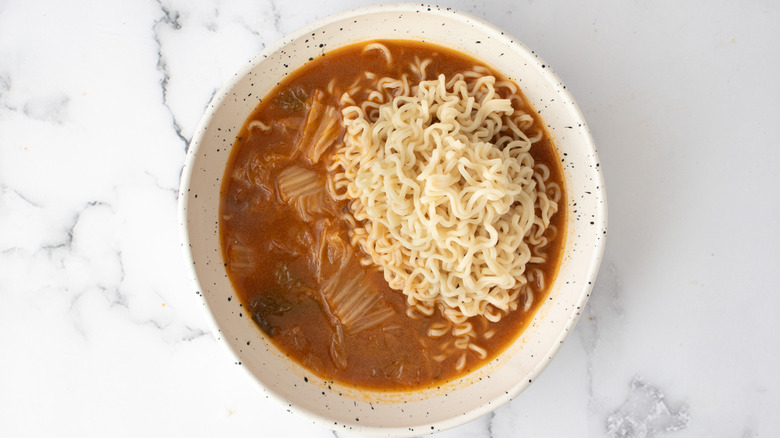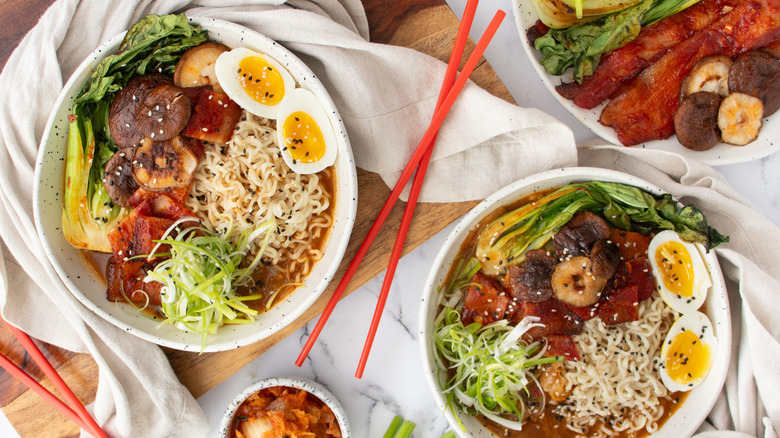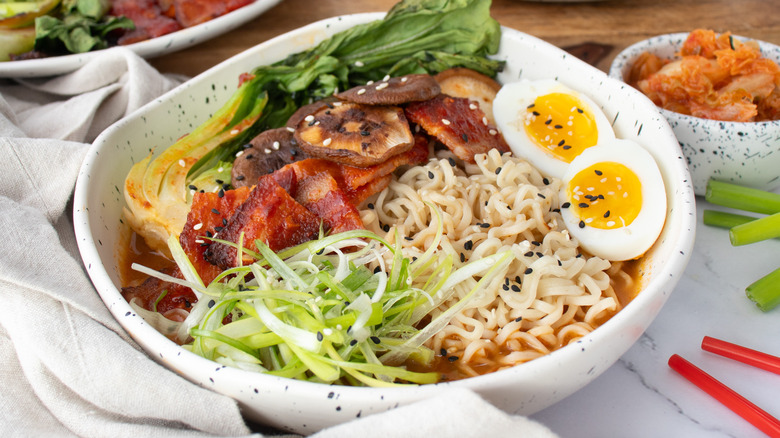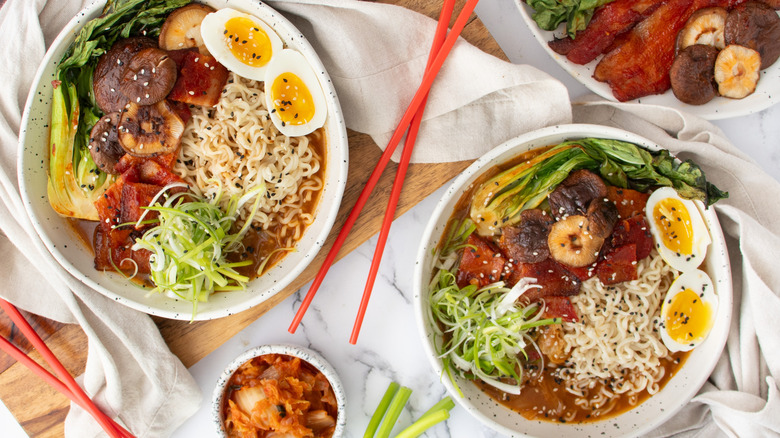Pork Belly Kimchi Ramen Recipe
Ramen can take on many forms, from cheap instant noodle packages to the opulence-brimming world's most expensive ramen. Mashed recipe developer Patterson Watkins brings her own take, by infusing the comfort food with Korean ingredients. A kimchi-infused broth and gochujang-basted thick bacon elevate this recipe with a few simple touches. "This mashup is awesome," Watkins raves. There's no need to make noodles from scratch for this pork belly kimchi ramen recipe either. Standard packaged ramen noodles fit right in, keeping this hearty dish easy to make midweek.
Watkins is a big fan of ramen, and reminisces, "Ramen was the first thing I ever learned how to cook! I loved it so much I even stuffed my Thundercats lunch box thermos with it just about daily." With this version, you might be inclined to eat it multiple times a week as well. Plus, a few of the components can be made ahead of time, allowing you to get home and have dinner on the table that much quicker.
Gather the ingredients for this pork belly kimchi ramen recipe
For this ramen recipe, you'll need thick bacon, gochujang, rice wine, and minced garlic cloves. Next, get shiitake mushrooms (de-stemmed), baby bok choy (halved), butter, and kimchi. Watkins notes, "Some kimchi may be spicier than others," and advises, "adjust the amount you add to your broth as needed and based on your preference." You could even make an easy homemade kimchi from scratch.
Get chicken or vegetable broth, soy sauce, sesame oil, fish sauce, packaged ramen noodles (cooked without the seasoning), and hard-boiled eggs (peeled and halved). The perfect hard-boiled egg might feel elusive, but Watkins' technique is straightforward. "My trick is the 6 minute 30 seconds hard boil," she says. "I wait until my water is at a rolling boil (high heat) before adding my eggs. And, once the timer goes 'ding' I immediately submerge my eggs in ice water and let them hang for 15-plus minutes (in their icy bath) before peeling."
To garnish the bowl, cut scallions into thin two-inch pieces. Watkins instructs, "Trim your scallions (remove the rooted ends and any sagging tops) and cut into one- to two-inch sections. Halve the white to light-green sections lengthwise ... then thinly slice/chop (again, lengthwise), creating thin, stringy pieces." If you want to take it up a notch, she recommends dropping them in an ice bath so the ends curl. Finish off the dish with black and white sesame seeds.
Step 1: Preheat the oven
Preheat oven to 400°F.
Step 2: Place bacon on sheet pan
Place bacon slices on a parchment-lined baking sheet.
Step 3: Make the gochujang sauce
Add gochujang, wine, and garlic in a medium bowl and stir to combine.
Step 4: Coat the bacon
Brush the bacon (both sides) with the mixture and place in the oven. Reserve remaining sauce.
Step 5: Bake the bacon
Roast the bacon for 15 to 20 minutes or until cooked through and crisp.
Step 6: Remove the bacon
Transfer cooked bacon to a plate, leaving as much of the pan drippings on the baking sheet as possible. Set the bacon aside.
Step 7: Add the veggies
Place the mushroom caps and halved bok choy on the baking sheet and put back in the oven.
Step 8: Bake the veggies
Roast the veggies for 12 to 15 minutes, flipping halfway through, until tender and lightly charred. Remove from the oven and set aside.
Step 9: Melt the butter
Melt the butter in a large pot over medium heat.
Step 10: Cook the kimchi
Add the kimchi and remaining sauce mixture to the pot, stir to combine, and cook for 2 minutes.
Step 11: Add the broth and sauces
Add the broth, soy sauce, sesame oil, and fish sauce to the pot, and stir to combine.
Step 12: Simmer
Bring to a simmer and cook, stirring occasionally, for 20 minutes.
Step 13: Cut the bacon
While the soup base is simmering, cut the bacon into bite-sized pieces.
Step 14: Add the noodles
Divide the cooked ramen noodles between bowls and top with broth.
Step 15: Add the remaining ingredients and serve
Divide the bacon, mushrooms, bok choy, hard boiled eggs, scallions, and sesame seeds between the bowls and serve immediately.
How can you personalize ramen?
Watkins' ramen garnishes add some greenery and a crunchy texture to the dish. Don't stop there though. "Load up them bowls, friends," Watkins recommends. "If you have a favorite garnish or ramen topper, don't let me hold you back." Perhaps you immediately gravitate to chili oil or bamboo shoots, or maybe you reach for a sprinkling of furikake and crispy bean sprouts. "I can see nori sheets working well. I can see those cute little swirly fish cakes working well. And, trust me on this, I can even see a slice of melty American cheese working well," Watkins says.
Although instant noodles are fairly nondescript, you can personalize the result by altering the cooking time. "I like to slightly undercook my ramen noodles," Watkins notes and cites 2 minutes and 30 seconds as her optimal time. As she points out "the noodles are going to continue softening when they get into that hot broth." If you want to prevent them from overcooking as you wait to serve, Watkins recommends placing the noodles in ice water and draining them when you're ready. "The noodles will reheat quickly in the hot broth," she reassures.
Can you prepare ramen in advance?
"Ramen, unfortunately, is best prepared and eaten ASAP," Watkins says — which shouldn't be hard to do with this delicious recipe. Customize the portion size if necessary to avoid ending up with leftovers that won't keep well. That said, if you want to incorporate this recipe into your weekly meal routine, Watkins suggests, "You can prep the broth and goch-sauce ahead of time to save on some day-of prep." Just be sure to seal them in airtight containers and keep refrigerated before using.
About the bacon, you may want to follow Watkins' advice when she says, "Double that batch (if you are a bacon aficionado, like myself) this bacon slaps!" Although you might also eat it all at once, it will keep fine in the refrigerator for a few days too. Reheat it in the oven or toaster oven and you can easily add it to your ramen bowl. For any extra bacon, Watkins' favorite ways to use it include on avocado toast, in grilled cheeses and BLTs, and as a "perfect side for scrambles." With these savory combinations, you'll achieve what Watkins calls "endless bacon bliss."
Pork Belly Kimchi Ramen
A spicy kimchi broth and roasted shiitakes and bok choy add tons of flavor to this ramen. And you're going to want to make some extra gochujang-coated bacon.
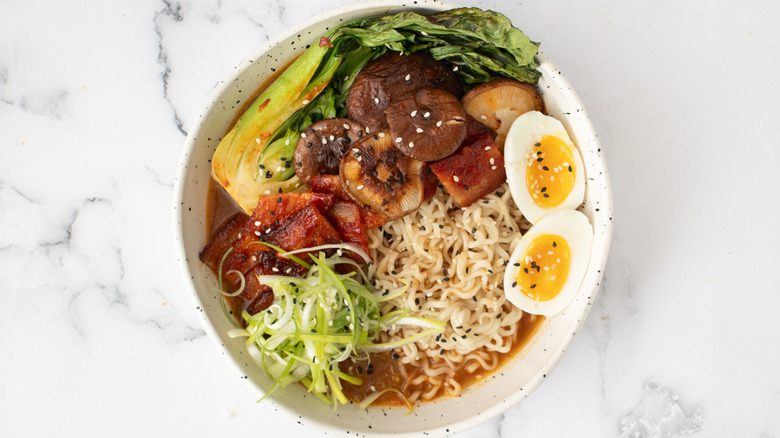
Ingredients
- 8 slices thick bacon
- 2 tablespoons gochujang
- 2 tablespoons rice wine
- 2 garlic cloves, minced
- 4 ounces shiitake mushrooms, stems removed
- 2 baby bok choy, halved
- 2 tablespoons butter
- 1 ¾ cups kimchi
- 4 cups chicken or vegetable broth
- 2 tablespoons soy sauce
- 1 teaspoon sesame oil
- 1 teaspoon fish sauce
- 4 packages ramen noodles (without seasoning), cooked
- 4 hard boiled eggs, peeled and halved
- ½ cup scallions, cut into thin 2-inch pieces
- ½ tablespoon sesame seeds
- ½ tablespoon black sesame seeds
Directions
- Preheat oven to 400°F.
- Place bacon slices on a parchment-lined baking sheet.
- Add gochujang, wine, and garlic in a medium bowl and stir to combine.
- Brush the bacon (both sides) with the mixture and place in the oven. Reserve remaining sauce.
- Roast the bacon for 15 to 20 minutes or until cooked through and crisp.
- Transfer cooked bacon to a plate, leaving as much of the pan drippings on the baking sheet as possible. Set the bacon aside.
- Place the mushroom caps and halved bok choy on the baking sheet and put back in the oven.
- Roast the veggies for 12 to 15 minutes, flipping halfway through, until tender and lightly charred. Remove from the oven and set aside.
- Melt the butter in a large pot over medium heat.
- Add the kimchi and remaining sauce mixture to the pot, stir to combine, and cook for 2 minutes.
- Add the broth, soy sauce, sesame oil, and fish sauce to the pot, and stir to combine.
- Bring to a simmer and cook, stirring occasionally, for 20 minutes.
- While the soup base is simmering, cut the bacon into bite-sized pieces.
- Divide the cooked ramen noodles between bowls and top with broth.
- Divide the bacon, mushrooms, bok choy, hard boiled eggs, scallions, and sesame seeds between the bowls and serve immediately.
Nutrition
| Calories per Serving | 813 |
| Total Fat | 49.7 g |
| Saturated Fat | 19.6 g |
| Trans Fat | 0.1 g |
| Cholesterol | 202.7 mg |
| Total Carbohydrates | 63.9 g |
| Dietary Fiber | 6.9 g |
| Total Sugars | 5.5 g |
| Sodium | 3,170.8 mg |
| Protein | 26.5 g |
